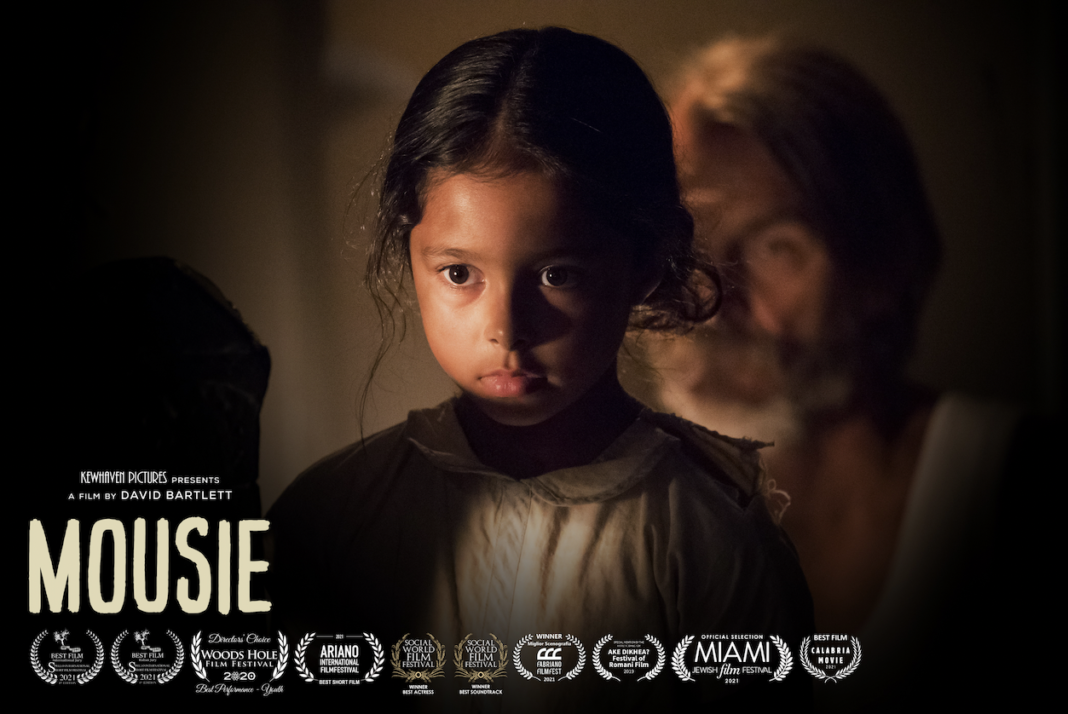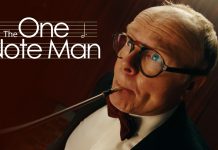David Bartlett reflects on the effect of the Holocaust in his acclaimed short MOUSIE.
Film And TV Now spoke with the film-maker about the film.
FILM AND TV NOW: There always seems to be a timelessness and an endless source of inspiration from stories set around World War II. What fascinates you about the period?
DAVID BARTLETT: I can think of few man-made events as dramatic or far-reaching or devastating as World War II.
Certainly there is no event close to my own timeline that has a more colossal influence. I can’t imagine a period more transformative, or more revealing about human nature under extreme pressure. Personally, I think the most fascinating – and chilling – revelation is how so many human beings were drawn down into a cult of nationalism and racism, incorporating a new level of absolute ideology.
MOUSIE is set before the war broke out, because I was interested less in fighting – the showdown – and more in seeing how the gradual descent manifests itself and how previously “normal” men and women descend… And I am just as fascinated by how other human beings survive or resist the tribal trauma and reach out to alleviate the suffering of others, often demonstrating the most breath-taking courage. And hope…
There’s always hope hiding in the corners of the worst tragedies. Different forms of the nationalist cult have emerged frequently ever since – sucking people in, misleading, dividing, harassing and destroying. So the example of that historic era and its people – victims and perpetrators – is still sadly, profoundly relevant.
FTVN: The cinematography in this film has a richness and colourful pallet. Tell us about your relationship with your DOP.
DB: Director of Photography Paul Kirsop and I are close friends who have worked on a number of projects over the years, and we delight in entertaining both contemporary approaches and techniques from cinema’s beautiful, rich history.
Can shadow and the denial of information be powerful? Is there a new tone to be found within an old pioneering noir technique? What expresses the story? We relish earning the attention – or discomfort – of an audience. So we approached the idea of lighting and lensing a period piece in a faded 1920s Berlin club with almost childish glee…
Such colours, such expressionism to be found! I needed a decayed, jittery cabaret club where the grotesquery of the stage performances seems to have infected the whole building under the poisonous shadow of Nazism. Paul and I determined that the key story elements of decay and alarm should be reflected in the cinematography, from the green-hued angular stairwell to the blood-red texture of the dressing-room and backstage.
We chose to shoot the film Anamorphic/ Cinemascope to amplify the smallness of the child without having to reduce her presence in the frame, and also to render a more inclusive theatrical proscenium appropriate to the principal setting. With all colours desaturated, life-drained – except for the one pinpoint of hope personified by the little girl and those deep, burning eyes.
Paul sensitively used light and shape to add a level of desperation, of growing tension to a club where everyone is hanging on by their fingertips… Performers, audience and a little mouse too.
FTVN: Tell us about your cast.
DB: For the central child character, we found seven-year-old Sasha Watson-Lobo through her dancing skills. But she had no acting experience at all. I have worked with children quite a few times, and decided to trust my instincts. Essential to a good child performer are sensitivity, imagination and discipline… And even without any experience, I felt that Sasha had such an emotional intelligence that she would interpret my guidance and access the character with empathy. I took a chance! And neither of us looked back…
Most obvious in the bewildered child at the heart of it, the key to ALL the characters is fragility… They all reflect trauma and insecurity, either as victim or perpetrator. Dancer Katharina needed to be courageous but clearly scarred and scared. Nazi-in-development Otto needed to be discovering himself, growing into his vile new role – as uncertain and tragic as anyone else in the club, the hissing pressure-cooker where all their paths cross.
I discovered musical theatre specialist CJ Johnson in the cast of super-musical 42nd Street at the Theatre Royal Drury Lane, and instantly realised the brittle edge she might bring to the heroic and brave Katharina – a strong, brave and talented woman. Cast as Otto, theatre veteran Jack Bennett was another lucky find, treading such a fascinating, chilling line between the lost boy and the brute, expressing something human and frail about man’s descent into savagery.
We were honoured when TV, screen and theatre doyen Nigel Cooke embraced the part of the “Nazified” comic, Kauz. I wanted him too to be repulsive, but a picture of tragedy at the same time. A reminder of what has been lost… Of something draining away… And Nigel delivered beautifully.
The entire cast understood the state of trauma, human frailty that I was looking for, rather than portrayals common to comic-book, good-vs-evil stories. And they were all SO committed and intelligent throughout the process, even Nichole Bird in the seemingly-insignificant role of the club stage manager: so subtly nervous, busy, just trying to survive, expressing so much about the bystanders of history. I couldn’t be prouder of the multi-faceted performances they conjured.
FTVN: Tell us about some of the other members of your production team.
DB: For a short, MOUSIE was very ambitious.
It represented a perfect storm: musical sequences, dance choreography, period props, extras, lead played by a young child, period locations, night-shoots. All on a miniscule budget. So, the pressure was immense. The majority of the production crew were newcomers and trainees in all departments – with some wonderful, experienced department heads, like DoP Paul Kirsop and Make-up Designer Laura Schalker.
For example, script supervisor Gabrielle Wood had only just started in the business; likewise Rio Clarke in the electrical department and the talented Daniel Addis taking the role of lighting gaffer for the first time. Judging by how it turned out, I feel this perfect storm actually emerged as a shiny showcase for the skills of so many young professionals who “pulled it off”, under the management of one of the most gifted and decent producers in the business, Will Poole.
With such an emotive story – and such magical performances – combined with a pride amongst the hard-working young crew, the atmosphere was electric. And then came the music… This element is essential to the meaning and plot of the film. It is always there, always providing a relevant texture or voice. Hélène has little dialogue, but her trauma and her innocent curiosity are voiced by BIFA-winner Jack Arnold’s award-winning musical score.
Working with Jack was one of the most joyous adventures of the production, and one of the sweetest relationships for me. Jack’s emotional take matched mine, and describing the film as a “horror without being a horror”, he created the perfect synthesis of tension, anguish and innocence, wrapping his music perfectly around the contemporary cabaret tracks I had selected, and elevating both texture and emotion at the same time.
FTVN: Tell us about the Production Designers and Costume Designers.
DB: Neither Producer Will Poole nor I had worked with Production Designer Mark Paine and Costume Designer Mary-Jane Reyner before this tricky and demanding project. But we lucked out…
Working with Art Director Kelly-Anne Robson and three trainees, Mark had an energetic and patient approach, and immediately understood what I meant by “the architecture of decay shot through with the energy that comes from both creativity and fear”.
We studied images of the old Kit Kat and Eldorado Clubs in Berlin’s crazy cabaret district Nollendorfplatz in the 1920s, and worked out what we could find and what we could afford. We were keen to reflect the colour and claustrophobia demanded by the story and incorporate period accuracy – even including the early electric pickup adapter fitted to the old gramophone in the auditorium!
While under a lot of pressure in an incredibly short period of time, Mark – winner of two Best Production Design awards for MOUSIE – was always galvanised, amplifying the faded reds and golds and desperate exuberance of a dying Weimar club… You can virtually taste the dust and cracked bakelite.
Similarly, Costume Designer Mary-Jane Reyner astounded producer Will Poole and I: instinctive, dynamic and sensitive to period and story in equal measure, she stretched her meagre budget to dress the cast and extras with characteristic bonhomie. I felt immensely blessed to have discovered Mark and Mary-Jane, and am awed by their miracles – big and small – whenever I see Mousie.
FTVN: You shot at Hoxton Hall. Tell us about the location design of the short and logistics of shooting there.
DB: The first hurdle was that our schedule had to fit around events being held at Hoxton Hall, which is a commercial performance venue.
And we knew that while The Hall was absolutely our best choice – based on atmosphere, availability and cost – it would need a lot of imaginative alteration and selective shooting angles to render the 1920s/ 1930s Berlin look we needed for the film, which was already an ambitious aim considering our budget.
We had to convert part of the entrance into a dressing room, since the genuine Hoxton Hall dressing rooms were way too small and modern to shoot in. We all had to be super-careful working around Hoxton Hall as it has government protection as a Grade II Listed Building, dating from the 1860s. So this made life harder when we transformed “the wings” by building a half-set to supplement the Victorian structure and installed 1930s-style practical lighting…
In the end, a lot of improvising and sticky-tape held our dream of a Weimar Cabaret Club together! But the people running Hoxton Hall were tremendously supportive from the start, which proved invalu
FTVN: How did you raise finance for the short?
WILL POOLE (PRODUCER): With no institutional funding at all, financing a period short was not an easy job!
We were delighted that a lot of people believed in the script at a very early stage and we raised the budget from donations from friends and family and key crew members. We were delighted that a number of suppliers came on board as sponsors with dramatic discounts, such as key locations, camera and lighting equipment and post-production facilities.
We certainly couldn’t have made the film without the support of Pixipixel, Independent Grip, Envy Post Production, Hoxton Hall and Chatham Docks. And The Richmond Shakespeare Society generously supplemented heavily-discounted costumes and uniforms rented from Angels Costumes.
FTVN: Your career began at the BBC as a Second Unit Director for BBC feature Happy Birthday Shakespeare. You have written and directed numerous dramatizations such as THE GREAT TRAIN ROBBERY, THE ASSASSINATION OF JFK and THE HITLER DIARIES, for the BBC. How did your experiences working on those films help shape doing a work like MOUSIE and what are the key lessons that you have learned over the years about writing and directing that you could share with others interested in the process?
DB: None of those history projects for the BBC had a good budget. They were tough to make, with incredibly short schedules. But they were commissioned with a (necessary) encouragement to be imaginative… Which in those circumstances really means: find a way to communicate big thoughts and big historic moments using only small details or gestures.
The mantra is “necessity is the mother of invention”. Not all compromises are reductive… If you’re resourceful and imaginative, you can find much more sensitive, powerful ways to depict the pain of battle or the crisis of a people without engaging 1000 extras or CGI.
MOUSIE aims to reflect the descent of humankind into brutality; the victimisation – and hopes – of an entire culture under threat; the trauma potentially felt by all child refugees, and the greatness of art as a weapon of hope… These are epic reflections… So just as I referenced the sorrow of men in an abusive regime in Wandsworth Prison by means of a shot of a tiny bird, shivering under the barb wire on its outer walls (The Great Train Robbery), so MOUSIE contains many epic reflections in the metaphor of a small child hiding from terror in a wardrobe, searching for her toy mouse.
To people wanting to tell stories that signify more than their immediate plots, I would say to remember that every person in an audience is the star of their own epic story, and sensitive to the small gestures in their own life… And they probably will be to small gestures presented on screen that reference events of an historic, universal nature.
FTVN: Would you like to expand on the themes in this film in a feature story?
DB: Oh yes, indeed!!! I’d love to see more of Hélène’s story…
Since MOUSIE is partly about dislocation – the backstory common to all refugees – I’d love to see the world she came from, what her expectations were, what made her smile. Essentially, everything that was taken from her. Always gut-wrenching, themes of dislocation and of demonization throughout history are common.
I’d love to focus on this process, and how people survive it. And certainly I’d love to explore our little mouse’s story once she has left the cabaret club… I am fascinated with the bravery of so many children who were forced – and still are – to confront a life and death flight that most of us will never have to deal with. Where does Hélène go..? Where will her ingenuity take her?
FTVN: How has the festival circuit helped your film evolve in the public domain?
DB: MOUSIE has been presented in 35 festivals across seven countries – UK, Germany, Spain, Canada, USA, Ireland and Italy – and has won more than 20 awards and nominations. And the feedback is not just good, but consistently strong. This is very humbling and rewarding.
It suggests that the film’s universal themes of humanity and prejudice and survival and fear and hope resonate as intended; that my aim to galvanise is hitting its target on a worldwide platform. At its screening at the Dublin Film Festival, Michael Doherty of RTÉ described MOUSIE as “Stylish, moving and profoundly topical”, and this seems to summarise the general view, and is certainly what I intended. And this has propelled a continued interest as the film continues to travel and resonate…
FTVN: What issues and themes are you keen to explore in your future work?
DB: I am drawn to emotional stories about human struggle, human endeavour… And human frailty. The human spirit can be indomitable under remarkable strain, but often even the powerful conceal a dangerous fragility. I am really interested in the “underdog”, the man, woman or child without power who embraces an epic and relevant struggle – whether it’s a medic with a life-changing theory or a child outwitting an ogre in a soldier’s uniform. And for me the most significant themes and conflicts are best exemplified in the emotional experience of the individual without authority.
FTVN: How has the global challenge of the last year and a half affected your development and evolution as a film-maker?
DB: I have focussed on writing while the pandemic made shooting either extremely challenging or downright impossible. I secured a wonderful opportunity with a prominent best-selling novelist, who invited me to work with him on the screen adaptation of his latest work.
The relief was huge – but such work has its challenges in these circumstances. Being in a lock-down state is bad, but the loneliness can be exacerbated by diving into your own mind for long, uninterrupted stretches. At the same time, for the artist everything is stimulating, broadening, revealing… So, seeing fellow human beings reacting to a universal shutdown was fascinating because it was new. However discomforting, it’s all nutrition for the writer.
FTVN: Finally, what are you most proud of about this short?
DB: I am proud that the film I set out to make was ambitious and heartfelt, and that its aims were not only realised so beautifully by the cast and crew – some of whom were working in film for the first time – but that audiences are engaging so emotionally with it.
I was especially proud when Romani holocaust survivor Zoni Weiss wept after seeing the film in Berlin, saying: “While the plot is different, SO much of this is my story, my bewilderment, my emotions as a child, hiding from the Nazis after they took my parents away from me…”.
It felt like the film had been granted the greatest – and saddest – credibility. I am proud that we used every element of cinema – including music, dance and rich cinematography – to emotionally advocate art as a weapon of hope… And that it appears to resonate with so many people worldwide.
For more about the short, please go to:





























